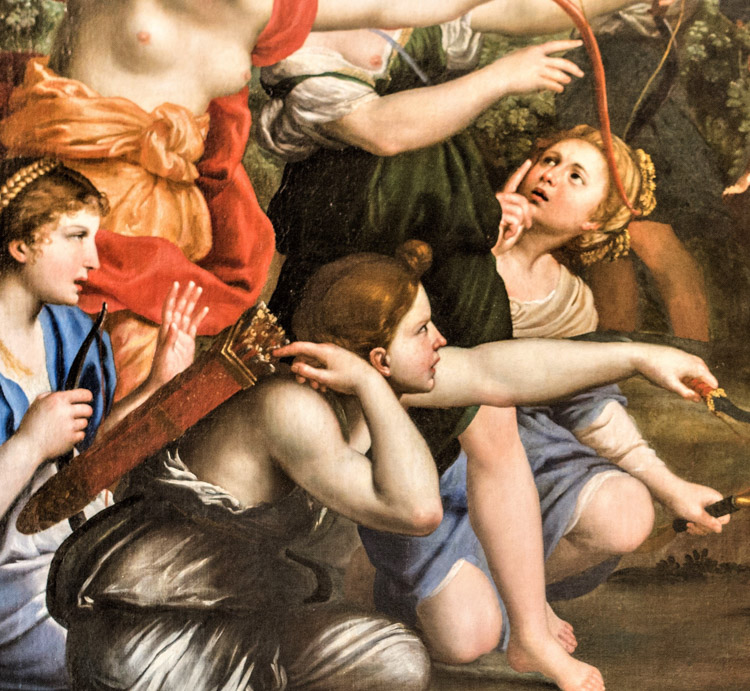
OBRAZY & RZEźBY Must-see paintings and sculptures
Domenichino’s The Hunt of Diana – a painting about spying and its unfortunate results

This mythological scene showing the goddess of the hunt Diana and nymphs who accompany her, only seems to be a genre scene. In it we see a group of girls – some are resting, others bathing, still others are firing their bows. We have just witnessed the triumph of the goddess, known for her marksmanship abilities – she has just hit a lapwing with an arrow – once again displaying her talents. The nymphs congregated around her seem to be completely occupied with the competition, not noticing two men hidden in the bushes, of whom one is looking upon the event, while the other is looking at us, letting us know that we should remain silent. We too become peeping toms, as if we were companions of the men and we cannot doubt that the nymphs and their leader will punish not only them appropriately, but us as well. The men represent allegories, as was often the case with Baroque painting. One of them expresses insatiable human curiosity (the desire to spy), the second the risk connected with it, which stands in the way of reason, as well as the desire of man to get to know that which is dangerous, forbidden and prohibited, which we cannot resist even in the face of death. We can only imagine the great danger that both the men find themselves in. The bird struck in its eye foretells certain death for these bold adolescents, who will be dealt with by the goddess, angry at their obtrusiveness, in similar fashion.
The nymph presented in the foreground lying in the water, is not distracted by the shooting feats, her attention is not diverted – she is watching carefully, as if she has already seen us hidden in the bushes. Only a moment remains until she lets Diana know about it and our fate will be sealed.
Combining the beauty of nature with the antique care for ideal form became the trademark of Domenichino, a painter completely apart from the community of naturalists from the beginning of the XVII century, represented by Caravaggio. An expression of this striving to convey this sublime beauty is the dispersed luminescence of colors common to his works, which he obtained by putting individual layers of paint upon one another, beginning with light colors and finishing off with dark ones.
The painting was commissioned from the artist by Cardinal Pietro Aldobrandini, a valued art collector, but it never came into his possession. Domenichino was forced to give up the painting by Cardinal Scipione Borghese and it became a highlight of the collection of the papal nepot
Domenichino, The Hunt of Diana (1617), 222 x 315 cm, Galleria Borghese
Może zainteresuje Cię również
Annibale Carracci (1560–1609) – a straightforward recluse in the world of Roman splendor
Zgodnie z art. 13 ust. 1 i ust. 2 rozporządzenia Parlamentu Europejskiego i Rady (UE) 2016/679 z 27 kwietnia 2016 r. w sprawie ochrony osób fizycznych w związku z przetwarzaniem danych osobowych i w sprawie swobodnego przepływu takich danych oraz uchylenia dyrektywy 95/46/WE (RODO), informujemy, że Administratorem Pani/Pana danych osobowych jest firma: Econ-sk GmbH, Billbrookdeich 103, 22113 Hamburg, Niemcy
Przetwarzanie Pani/Pana danych osobowych będzie się odbywać na podstawie art. 6 RODO i w celu marketingowym Administrator powołuje się na prawnie uzasadniony interes, którym jest zbieranie danych statystycznych i analizowanie ruchu na stronie internetowej. Podanie danych osobowych na stronie internetowej http://roma-nonpertutti.com/ jest dobrowolne.